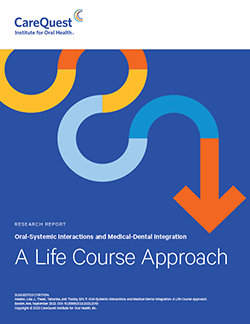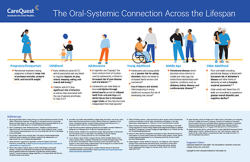Oral Health and Overall Health Across the Lifespan
This report from CareQuest Institute provides a comprehensive overview of the bidirectional nature of oral and systemic diseases across different life phases and discusses how medical-dental integration (MDI) can improve access to care, health outcomes, and health care costs.
Key points include:
- In addition to improving health outcomes, MDI reduces costs. For example, one study predicted that providing individuals who have diabetes and periodontitis with periodontal treatment would save each individual an average of $5,904 in health care costs.
- One example of the MDI model is the integration of dental health into well-child visits (WCVs). Children who have a dental assessment during a WCV are more likely to have a preventive dental visit. However, a very small percentage of children receive a dental exam during a WCV ― less than 3%.
- A major challenge for the MDI model is the infrastructure needed for sharing patient information. Some large hospital systems have shown how integrated electronic health records (EHRs) can reduce gaps in care, improve access to care, and improve patient outcomes.
- Establishing integrated care models will require a shift for whole organizations ― starting with leadership buy-in, building infrastructure, and closing referral loops.
To increase the success of MDI, the report recommends education for the health care workforce, changing the scope of practice for dentists, and increasing patient awareness.
You may also be interested in:
- Medical and Dental Integration: A Need for Improved Electronic Health Records, a visual report that explores the barriers that dental and medical providers experience in accessing and sharing patient health information.
- Periodontal Treatment Associated with Decreased Diabetes-Related Treatment Costs, an article in the Journal of the American Dental Association that finds overall health care costs were reduced for patients with diabetes who received periodontal treatment.
- Medical Well-Child Visits and Preventive Dental Visits, an article in JDR Clinical & Translational Research that evaluates the impact of well-child visits on promoting preventive visits to the dentist.

